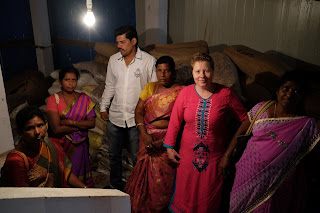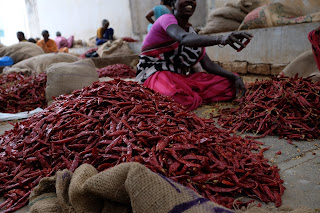Tuesday -
Okay, so no substances were taken today, but what a surreal experience the day was. Setting off to Hindupur today for a cultural and organisation experience day, we picked up Mani, Radha, Govindamma and Ratnamma.
Our first stop in Hindupur was an old age home, meeting some very friendly and lovely people. Mani, Radha, Govindamma and Ratnamma were surprised to find that they knew one of the women in the old age home. The old age home is staffed every day of the year, including holidays, with the funding being 75% and 25% privately. Old age residency's are a very important thing in India, as apparently some of the elderly are not treated well, with many facing homelessness as they are seen to no longer contribute to the household or family and consequently kicked out from their home, or only receiving leftovers of food (if there are any leftovers).
After the old age home, we went to the silk market, where silkworm cocoons are sold and brought. The cocoons are divided up into quality and colour - colour often denoting quality
After the silkworm cocoons, we proceded to a market where they sell dried chill and tamarinds. After seeing how the chili's were prepared, we went into a refrigerated 8 level storing facility that the farmers pay to rent space. Inside the storage area, the smell of spices was heavy, but pleasant (apart from the constant sneezing everybody experienced). We were also informed that the storage area also facilitates storage of maize (corn) and coriander. There was also a non-refrigerated silo outside, but we did not see inside it.
After the markets, we had a brief stop at a tractor store, where the staff took care of some business for the SEDS farm. On the opposite side of the road was a cemetarty which backed upon a large dump site. I found this juxtaposition quite interesting. The area was also surrounded by large, beautiful carpenter bees.
We then set off to the hospital, where I saw a man I had previously saw this morning. This man was wearing nothing but a poncho and was pulling it up for his behind to be exposed to everyone who had the fortune of looking. While I can not say for sure, I would presume he was a person with a disability. People with disabilities are also treated quite differently in India, specifically in the more rural and village areas as there is still some superstition around them, as well as them not being deemed to contribute to the family and household, resulting in them being evicted from the house and family (similar to elderly). Even if the people with disabilities have an impairment which may prove to be quite challenging for them, they are often able to survive, found wandering from village to village. They survive as many people just give them food so that they will move on and leave the area. This treatment of individuals and possibly being from a low income family, means that the people with disabilities may get little assistance for their impairment. However, people with disabilities who only encompass a mobility impairment often are afforded assistance such as adjustment to motor vehicles so that they may drive. I've also seen a school specifically for people with autism spectrum in Bangalore.
So in pointing out the cultural views and beliefs of people from a wide variety of socially classified groupings, it is important to realise that the treatment of these individuals varies just as the personality of individuals across India. That while some views and beliefs may maintain and are or were generalised, culture and society continues to shift. The treatment of and beliefs about individuals are not a constant across India.
Arriving at the government hospital, a two story building with beautiful stone and marble everywhere. The upper floor section is only 2 years old, funded by the politician of the district who everybody seems to love as he also made healthcare accessible and affordable to all. We were ushered in, with all eyes on us. I personally felt as though everyone presumed we were doctors, here with the 'cure' to everybody's ailments. I felt this even more when we were brought into the premature and underweight infant section. In this ward, mothers were sleeping on the floor next their babies. Presumably exhausted from spending every waking moment next to their side. None of the mothers seemed to have been told that why we were there, and I personally did not not how to act other than not showing any worry and being as respectful as possible. This experience was even more difficult as the language barrier between us and the mothers made a complex situation even more confusing. Although after the premature and underweight infant ward, it was slightly cheered up by the fact we visited the children ward where everyone was quite excited and in high moods to see westerners. We briefly chatted to some of the nurses, trying to understand the layout and workings of the government hospital.
After, we went to a private hospital, where one of the nurses was a previous SEDS employee. We were taken upstairs to wait for the doctor, and greeted by a happy-go-lucky girl introduced as the 'doctor in training'. The girl was the doctor's daughter and we were welcomed into her house - a portion of the hospital in the upper floor. While waiting for the doctor, we were excitedly shown her two pets, Indian ring-neck parrots. Once the doctor arrived, we had a brief chat to him. He told us of all the work he's done in rural areas for charity, funded by him. He also said one of the biggest differences between the government hospitals and private, is that the private hospitals will always have a doctor there. We were also later told that many people seeking doctors often go to government hospitals first, then to a private hospital for a final opinion - if they can afford to do so.
Arriving home, I went up and joined the children being tutored briefly, however as many of the children were from schools other then SEDS, I could see myself being more of a distraction and hindrance to their learning then the help I could provide.
 |
| A guinea fowl blending in with the chickens at Somandepalli |
 |
| This little bike went to market |
 |
| And these little pigs loitered outside the old age home |
 |
| Living conditions of an Indian old age home |
 |
| Friendly reunion |
 |
| Everybody in the picture now |
 |
| The manager of the old age home |
 |
| SEDS and old age home members |
 |
| One of the friendly residents |
 |
| A cheeky old resident who plays practical jokes on other residents |
 |
| The resident dog |
 |
| Silk cocoon market |
 |
| Prices and dealings |
 |
| Asu Kumar - One of the Silk Farmers selling his wares |
 |
| Sorting the silk cocoons |
 |
| Chilli market |
 |
| The workers of the market de-stemming chilli's |
 |
| Chilli, Tamarind, Maize (Corn) and Corriander storage |
 |
| Radha and Mani |
 |
| Second Floor |
 |
| The only group photo of people not sneezing |
 |
| Workers of the storage facility |
 |
| Work stations |
 |
| Don't wake sleeping dogs |
 |
| External storing facility |
 |
| SEDS and one of the manager of the storing facility |
 |
| Group and I |
 |
| Transportation process |
 |
| Chilli preparations again |
 |
| A different chilli preparation facility |
 |
| A different type of chilli being prepared |
 |
| The owner of this chilli preparation facility |
 |
| SEDS employees looking at tractors for SEDS |
 |
| Graveyard and dumping area |
 |
| Carpenter Bee |
 |
| Side streets of Hindupur |
 |
| The rains of Hindupur |
 |
| Monkey shelter |
 |
| Disturbed monkeys in the rain |
 |
| Government hospital with a sign for their underweight and premature infant ward |
 |
| The politician who made the hospital provisions available in the district |
 |
| The 'doctor in training' |
 |
| Pet Indian Ringneck |
 |
| Our hosts of the private hospital visit |
 |
| Private hospital nurses |
 |
| Local of Hindupur |
 |
| Flowers for sale in Penukonda |
 |
| After school tuition |



















































Comments
Post a Comment